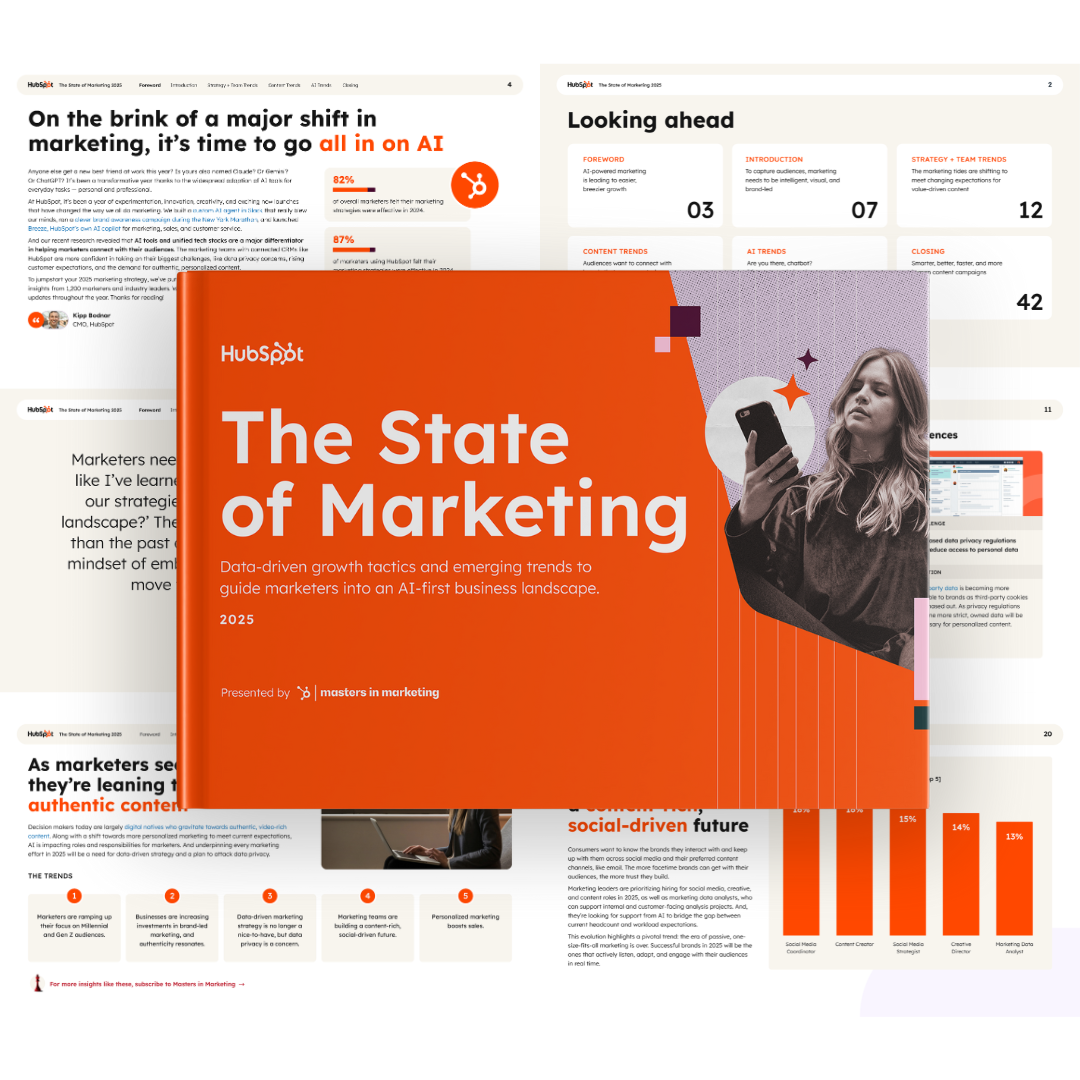My name is Meg, I oversee HubSpot’s full portfolio of English language blogs. And, I’m tired, y’all.
The HubSpot Blog Team is made up of 23 incredibly talented and experienced writers, editors, and strategists. We work with a world-class Content SEO Team. We have the domain authority of being the HubSpot Blog. And … we’ve been challenged to keep up with the rapid pace of the change demanded from us over the last year.
If we’ve found it challenging, I know there are probably a few others feeling the same. So, I thought we’d share some of our playbook with you. It might be similar to yours or it might have a few nuggets you find helpful.
Regardless, it’s rough out there. So the more knowledge sharing we do, the better, right?
In the beginning, there was an update.
The month was March. The year was 2023. The update was Core.
For the uninitiated, Google rolled out an update to its Core Algorithm in March 2023 (what we refer to internally as the “M23 update”). This is nothing new. Google rolls out updates a few times a year. They fix bugs, ensure high-quality SERP results, and move the search-driven world merrily along.
But this algorithm update was different. The impact it had on many publishers would be felt over the following months.
Here’s a snapshot of the organic traffic HubSpot’s blogs saw before the M23 update:

Pre-M23 update: Were we ever this young?
And here’s what things looked like once the M23 update finished rolling out:

Post-M23 update: Trust me, it got worse.
Our Content SEO Team flagged a few areas in which our blog properties were hit hardest:
- Page Experience: The blogs were negatively impacted by our technical page experience, specifically page speed and performance.
- Content Freshness: Content freshness also negatively impacted our performance, specifically posts that had not been updated in 571+ days.
We have a lot of graphs showing the sharp declines in page experience, but they all look pretty much like this:

This was fun to explain to leadership.
Our Technical SEOs immediately dug into page experience. But what did the Blog Team do?
Well, first we panicked, re-evaluated our career decisions, and pondered the end of the written word as we know it. You know, the sorts of things introverted English majors-turned-marketing-writers do.
Then, we looked at the data, and immediately began to overhaul our approach to content on the Blog. This really hinged on the increasing value Google appeared to be putting on experience-driven content (i.e., the new ‘E’ in E-E-A-T)
Wait, what’s E-E-A-T?
If you work in content, you’re probably familiar with Google’s Search Quality Rater Guidelines. These are the criteria Google uses to evaluate what content it surfaces to users in the SERPs. The E-E-A-T acronym stands for expertise, experience, authority, and trustworthiness.

In 2022, Google added an additional ‘E’ for ‘Experience’ to this acronym, and after the M23 update, we felt the effects.
The publishers most impacted by experience-driven content were:
- Trying to rank for a wide range of topics.
- Providing no evidence the author has proven experience with the topics they’re writing about.
- Product reviews/roundups based on what others have said.
The HubSpot Blog was guilty on all counts. Our library spanned hundreds of topics across multiple industries. Our writers were expert researchers and generalists, but they didn't always have direct, lived experience with every single topic they wrote about.
Who was winning in the experience era? It was publishers who:
- Provided ample evidence of real experience (like writing in the first person).
- Added original images, screenshots, and video.
- Included unique anecdotes you wouldn’t have unless you actually tested the thing yourself.
Armed with this information (and more than a little humility), we got to work.
The HubSpot Blog’s E-E-A-T Case Study
Is there anything a marketer loves more than running a case study (except for becoming a moderately successful LinkedIn influencer)? HubSpot Content SEO Strategist Ivelisse Rodriguez E-E-A-T-ified our first blog post based on the E-E-A-T playbook SEO Bianca (Binks) Anderson developed.
Their work (and that of many other unnamed stakeholders) built the framework for how the HubSpot Blog approaches “E-E-A-T-ified” content (i.e., content that’s less susceptible to AIOs and more likely to rank).
The case study focused on E-E-A-Tifying/historically updating our 17 Best Free Website Builders to Check Out in 2024 [+Pros & Cons] blog post.
Why this post? Well, it was a top driver of traffic, leads, and signups for the business, but demand had become volatile after the M23 update:

This is totally fine, right?
And here’s the massive boost in traffic the post enjoyed after Rodriguez’s successful E-E-A-T-ification:

Go on, Ivelisse.
Signups alone increased +251% and CVR followed at +26%. How did Rodriguez do it? Simple, she made (E)xperience Soup. Here’s her recipe:

She infused lived experience with her personal opinions and balanced it all out with an objective observation. Boom, a tasty soup packed with leads, traffic, and signups. Everything a growing marketer needs.
She used this recipe as a framework for structuring the entire piece. Take a look:
- Personal Anecdote: “I Can’t count the number of WordPress.com sites I’ve built for fun. It’s easy to sign up, it’s free, and its included domain name is not as ugly (and more recognizable) than others on this list. “Brandname.wordpress.com” has a nice ring to it, right?”
- Subjective Opinion: “The themes are modern and mobile-optimized. I was surprised to find that I liked quite a few of the designs. When I’ve used WordPress in the past, I found the themes lackluster, but it seems to have updated its library.”
- Objective Observation: “Keep in mind that the site is still in the bare minimum stages. You still need to go into the dashboard and add pages and content. Unfortunately, on the free version, you can’t install plugins, including the HubSpot Wordpress marketing plugin.”
Of course, it’s easier to make (E)xperience Soup when you have experience with the product or subject matter you’re writing about. But how do you take an E-E-A-T-ified approach on a subject you have limited experience in? Let’s take a look at how Rodriguez approached this challenge:
- Personal Anecdote: “I was surprised to see that Webflow includes different workspaces, something I didn’t run across in other tools (except CMS Hub, which allows you to have access to different portals). This makes Webflow an excellent choice for large teams where you might have different workspaces depending on permissions or job function.”
- Subjective Opinion: “Webflow’s page builder is complicated and the learning curve is steep. While the tool does include a setup checklist, it’s not as simple to follow as others on this list.”
- Objective Observation: “You can add HTML elements such as sections, containers, divs, lists, buttons, headings, and so on. The tool does include more technical language, so you’ll encounter terms such as “V Flex,” which refers to a vertical flexbox.”
Rodriguez is transparent about using the product for the first time. She’s also open about what she liked and didn’t like about Webflow’s functionality — something pre-E-E-A-T HubSpot bloggers would never …
The full E-E-A-T treatment for this piece focused on a few areas:
- Demoing the products, focusing on a beginner's perspective. Gone are the days where publishers could round up the top product reviews in the SERPs and build upon them for a skyscraper-type listicle. Real-world insight and experience with the products are non-negotiable.
- Truncating the list from 17 to seven items, using personal preference and an un-scientific method. We can talk about those Google leaks in another post, but even before that peek behind the curtain, we knew shorter lists would allow us to go deeper into our topics — an important E-E-A-T factor.
- Writing the article in first-person point of view, creating (E)xperience soup by mixing in personal anecdotes, subjective opinions, and objective observations.
- Incorporating personal opinion and personal experience into the post. Rodriguez states her experience in the first paragraph of the piece. And she’s clear about what she likes and doesn’t like about each product.
The success of Rodriguez’s case study led us to overhaul our approach to blog content. We threw out the organic strategy that worked so well from 2017-2022 and embraced a new HubSpot style that would help us write the best-possible content for our audience and remain competitive in the SERPs.

Don't call it a glow up.
We’re certainly not out of the immensely convoluted Google woods yet. But I’m proud to share that the portion of HubSpot blog posts our team has E-E-A-T-ified over the last nine months have stabilized and, in some instances, seen increases that rival our original case study.
I see you.
Maybe it’s been a minute since someone said this to you, but your written work is so important. Your content strategy is valuable. And the words you string together for email copy, blog posts, and YouTube scripts are appreciated.
Content folks are a scrappy bunch, and I think we’ve all become a bit better over the last year. I’m excited to see us continue to evolve, and I hope to share more of how the HubSpot Blog is changing with you soon.
SEO






.png)




.jpg)
![The Future of Google: Web Strategists Predict How AI Overviews & Other Search Changes Will Impact Traffic [New Data]](https://53.fs1.hubspotusercontent-na1.net/hubfs/53/seo-sge-1-20241031-8247348.webp)
